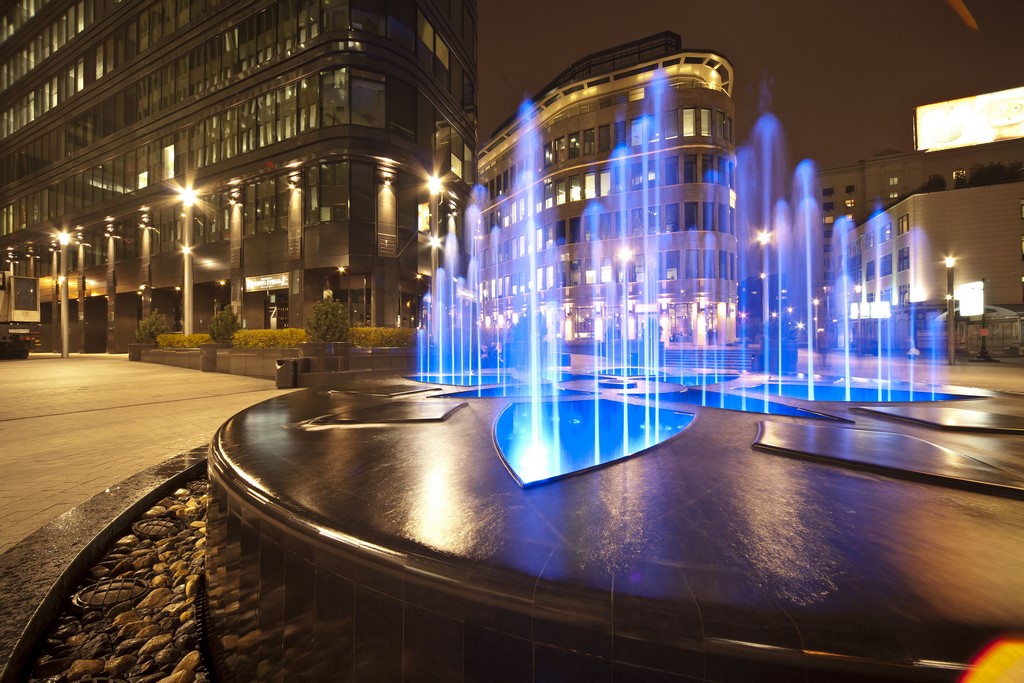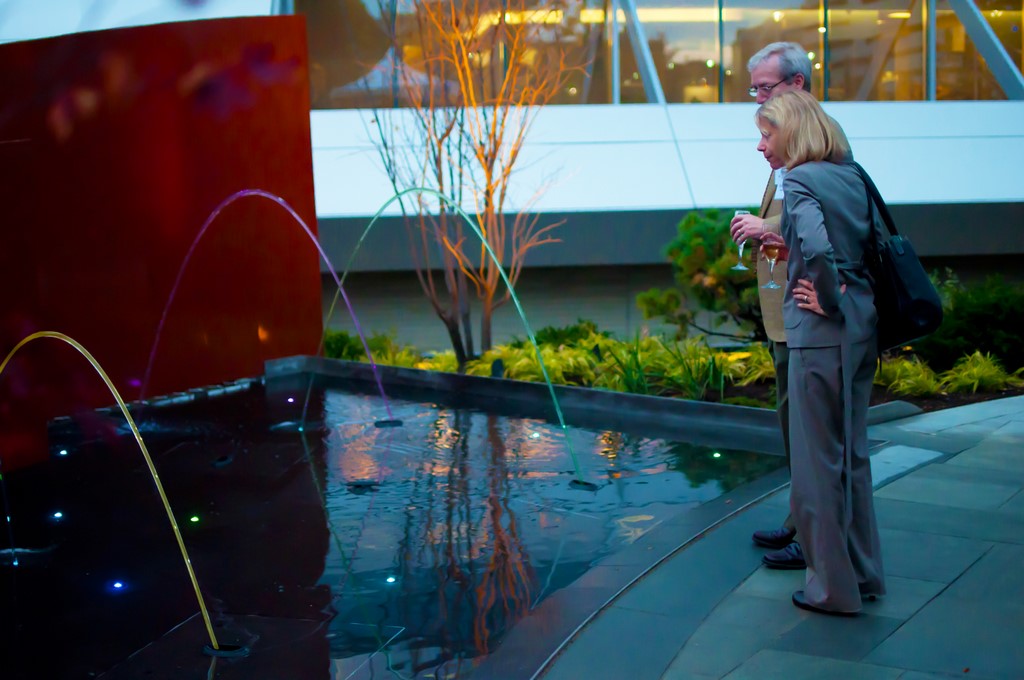Water’s Place

As watershapers, we’re comfortable using our chosen medium as a place-maker, an entertainer and a resource for recreation. In doing so, we take advantage of the fact that water is a unique, extremely versatile substance that can be manipulated in innumerable ways.
We also accommodate the thought that, supreme among design media, water has a pronounced and often profound effect on people who approach it: It captivates the eye and the ear, has a soothing influence on the spirit and may inspire awe and wonder. On so many levels and in so many forms, water is a deep-rooted and familiar source of human enjoyment.
For proof of its power, all you need to do is hang out around a splash pad on a hot summer’s day.
But as we all should be aware, water is also an increasingly precious resource – one that should only be used with care and an eye toward conservation. In this three-part series of articles, we’ll start by defining water’s awesomeness as a substance, then move on to detailed discussions of how best we can balance the desire for waterfeatures with the need to design them sustainably.
Let’s start here with a look at the Big Picture – one of the biggest of them all.
WATER’S MEANING
Marine biologist Wallace J. Nichols has studied the effect water has on our mental health through both quantitative and qualitative research. His findings are outlined in a book in which he argues that we all have “blue mind” defined as “a mildly meditative state characterized by calm, peacefulness, unity, and a sense of general happiness and satisfaction with life in the moment.” It’s all triggered, he writes, when we find ourselves in or near water.
This state of mind rests largely on the assumption that watching water allows our brains to relax while still operating in a form of “soft fascination.” That is, we’re still consciously thinking, but we aren’t overwhelmed by heaps of incoming information – as we might be if we were watching a television show, say, or working on a computer.
| If you need any convincing about the joy water imparts to people of all ages, just stand by and watch what happens in interactive fountains: The children are mesmerized, and you’ll get the sense that their adult companions wouldn’t mind getting soaked alongside them. And the fascination continues, as seen at right, even when the weather gets chilly. |
The presence of water has been shown to reduce stress, increase feelings of tranquility and lower both heart rate and blood pressure. This is why water is a popular component in healing gardens at hospitals: Patients and their loved ones use these spaces to escape the difficulties of treatment, and it’s also a fact that hospital patients whose rooms offer them a view to water in a green space exhibit quicker recovery times and shorter hospital stays compared to patients whose rooms do not offer such prospects.
Here and elsewhere, Nichols declares in Blue Mind (Back Bay Books, 2014), we find evidence of water’s role as a naturally fluctuating stimulus: In fact, exposure to water in any form leads to increased concentration and reduction of cognitive fatigue. This stimulation is often accompanied by an increase in self-esteem and an improvement in mood.
|
References Do not hesitate to find a copy of Wallace J. Nichols’ book, Blue Mind: The Surprising Science That Shows How Being Near, In, On, or Under Water Can Make You Happier, Healthier, More Connected, and Better at What You Do (Back Bay Books, 2015). As the title conveys, it’s about the essence of what we work with daily as watershapers. — R.M. |
Coupled with water’s visual appeal is a singular auditory component, whether it’s the sound generated by the trickle of a stream or the rush of a waterfall: This is yet another source of stress reduction, no matter the sound’s level or profundity.
These are phenomena that, across the board, watershapers use daily in their work. Along with architects and other designers, we all do what we can to capitalize on the multi-sensory attributes of water in order to enhance the experience of a space in a manner that is soothing, prompts contemplation, enhances mood and provides mental restoration.
In doing so, we know well that we should avoid predictability and/or monotony; choose naturally fluctuating movement rather than any appearance of stagnancy; and be restrained enough in our approaches that we don’t create discomfort through too much turbulence or noise. We should also be aware of the value of mixing things up, using water in different dynamic styles to keep people engaged and, better still, to offer up opportunities for surprise and delight.
VALUED RESOURCE
As we watershapers roll through these possibilities and determine which design solution is most appropriate for a given site, client and set of intentions, we all must recognize as well that water is the most important natural resource we have on our planet and therefore should be used wisely, with conservation in mind.
The tension between the desire to enthrall onlookers and the necessity of saving water is a challenge designers face with increasing frequency these days. Among manufacturers in the fountain sector, which includes people where I work (Crystal Fountains of Toronto, Ontario, Canada), we are constantly asked to devise and deliver both captivation and conservation in single designs.
| Water is the centerpiece for many of the ‘healing gardens’ that have become so common on the grounds of hospitals and convalescence centers. Studies have shown that these waterfeatures’ ability to calm patients and members of their families have significant effects in speeding recovery and elevating the spirits. |
That sounds direct, but approaching projects in this way has meant revising the way fountain projects have traditionally been approached. Historically, these waterfeatures were defined as essential project components – then were promptly forgotten, hanging on as no more than a blue splotch on a site plan and as a line item in the budget. Everyone simply assumed that the watershape would somehow come together at the appropriate time – if, that is, it came together at all.
In fact, within today’s context of captivation and conservation, this back-end strategy often leads to unfavorable results. When sustainability-related criteria are applied late in the game with such projects, the proposed watershape is often cut because there’s no way at so late a stage to handle the conservation concerns associated with the feature’s water usage, space requirements and energy efficiency. Frequently, this results in great ideas being left on the table because poor planning and the project’s time constraints never allowed for consideration of the sustainability issues involved.
| The best way to optimize the ability of fountains like these to function sustainably and responsibly in any setting is by integrating them into the design of the total space, tying them into the associated buildings’ plumbing systems and establishing control systems that are part of the whole composition. |
Fortunately, more and more project teams these days are recognizing this cluster of problems and are addressing them by considering and fully accounting for waterfeatures much earlier in the planning process – right up there with the design of the other project systems. This approach, often referred to as “integrated process design” or “holistic design,” helps ensure that all parts of a project work together in the pursuit of sustainability goals.
Thus, waterfeatures are now treated no differently than any of the other systems present on a sustainable project. This means that irrigation, ventilation and electrical systems are designed to work together to achieve the best and greenest possible results. This also means that fountains and other watershapes are less likely to be cut.
There are advantages, it seems, to being an integrated project component rather than a forgettable blue smudge.
TASKS AT HAND
Let’s conclude the first part of this three-part series with a brief case study that takes a look at Mother of the Nation Park in Abu Dhabi in the United Arab Emirates.
| Mother of the Nation Park in Abu Dhabi in the United Arab Emirates is a case study in using tested water-management principles in system design. There are 14 waterfeatures here in an extremely hot, arid desert climate, but the use of low-flow effects, basins with reduced surface areas and light-colored interior finishes in an integrated design approach makes it all work sustainably. |
One of the largest and oldest parks in Abu Dhabi, Mother of the Nation Park was overdue for serious attention, and the project team decided to do it the right way by applying the principles of holistic design. There were three goals here: build a sense of community, set sustainability as a key goal and put an emphasis on family fun and entertainment.
After a comprehensive facelift, the popular park is now home to numerous amenities, including 14 modern waterfeatures.
|
Credit Watch This series of articles is an expanded version of a course prepared for use by architects participating in AEC Daily’s continuing-education programs. AEC Daily is registered provider of these courses and offers them free through its web site, which also offers extensive product information and industry news. To learn more, visit aecdaily.com. — R.M. |
In keeping with the Park’s sustainability goals, the fountains were designed to conserve water while maximizing enjoyment; define multi-use spaces; and suggest pathways and destinations for park visitors. In addition to using low-flow effects and minimizing the area of each fountain basin, light interior finishes were selected to reduce basin evaporation in Abu Dhabi’s arid climate.
To incorporate the fountains seamlessly into this sustainable project, an integrated process approach was employed from the outset. Other initiatives here, for example, included using reclaimed greywater for irrigation to such a great extent that more than 200 mature trees were relocated to and now thrive on park grounds.
The approach works, but as we’ll see next month, there’s much more to it than pushing detailed discussions about waterfeatures to an earlier point in the design process.
This water-first strategy is now being used in projects around the world. We’ll consider several more of them as case studies in upcoming parts of this series, which will pick up next time with a discussion of water-sourcing strategies and will conclude a month after that with a look at site considerations and energy efficiency.
Robert Mikula is director of special projects at Crystal Fountains, an international waterfeature specialist based in Tioronto, Ontario, Canada. He has more than 20 years’ experience in design and project management and is also a registered landscape architect who spent several years designing aquatic theme parks before taking his current post. Mikula is also active on the education front, having participated in many seminar programs and written numerous magazine articles on water effects, illumination and systems design. For more information, visit www.crystalfountains.com.


















